Lütjens Options.
 after the Iceland Battle. |
The decision to head for Saint-Nazaire shows that after a survey of the damage sustained, Lütjens had correctly decided to cancel Operation Rheinübung at least temporarily until the Bismarck could be repaired in port. But, why did he choose Saint-Nazaire? The French port was farther than Norway and it required greater fuel expenditure. Lütjens probably thought France was the best place to resume the battle of the Atlantic as soon as possible following Raeder's wishes. In fact, he had successfully entered Brest withScharnhorst and Geneisenau a couple of months earlier.
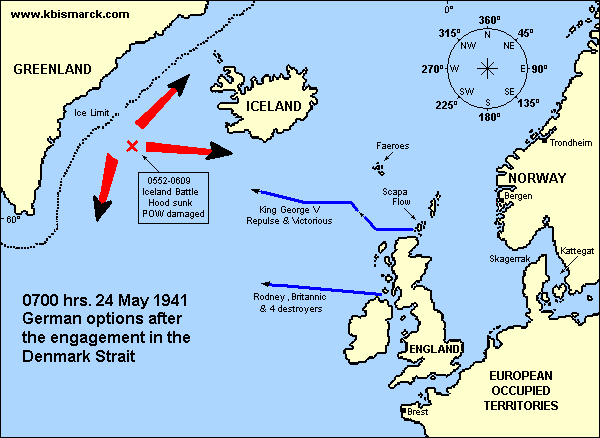
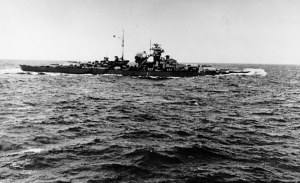
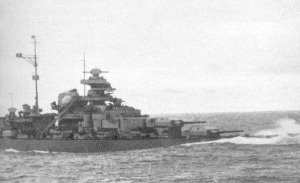
The unexpected sinking of the Hood caused enormous indignation in London, and the British Admiralty began to divert all available warships from their original missions in order to join in the chase for Bismarck. This included leaving most convoys that were at that time crossing the Atlantic unescorted.
The battleship Rodney (Captain Frederick H. G. Dalrymple-Hamilton) was at sea to the west of Ireland on her way to Boston for repairs with destroyers Somali, Tartar, Mashona, and Eskimo of the 6th Flotilla escorting the liner Britannic (27,759 tons), now used as a troop transport. The Admiralty ordered Rodney to operate against Bismarck and at 1036 on the 24th signalled: "If Britannic cannot keep up, leave her behind with 1 destroyer." Therefore Rodney and destroyers Tartar, Mashona and Somali left Britannic with destroyer Eskimo at noon. The battleship Ramillies (Captain Arthur D. Read) to the South of Cape Farewell was also instructed to leave the convoy she was escorting (HX-127) and "proceed so as to make contact with enemy from westwards, subsequently placing enemy between Ramillies and C.-in-C". In addition, the battleship Revenge (Captain Ernest R. Archer) in Halifax was ordered to put to sea, and she left port at 1500, then headed east.
The Prinz Eugen is Detached.
Early in the morning of 24 May, Admiral Lütjens had already decided to detach the Prinz Eugen, and at 1420 sent a semaphore signal to Captain Brinkmann:
- «Intend to shake stalker as follows: During rain squall, the Bismarck will change course west. Prinz Eugen will maintain course and speed until he is forced to change position or three hours after the departure of Bismarck. Subsequently, is released to take on oil from "Belchen" or "Lothringen". Afterwards, pursue independent cruiser war. Implementation upon cue word, "Hood".»
The fuel situation aboard Bismarck had become serious, and at 2056, Lütjens informed Group West that, due to fuel shortage, he was to proceed directly to Saint-Nazaire. In fact, at this time the Bismarck had less than 3,000 tons of fuel-oil available, and unless some of the 1,000 tons of fuel blocked under the forecastle could be retrieved, the battleship would be forced to slow down in order to reach the French coast. HadBismarck been refuelled in Bergen on 21 May, now she would have some 1,000 tons more of additional fuel available. That would have given Bismarck more freedom of movement and would have enabled Lütjens to make a diversionary manoeuvre to try shake off his pursuers. But the reality was that the fuel shortage hampered the original idea to drive the pursuing British forces into the western U-boat screen, and it forcedBismarck to follow a steady course to France. As a result of this change of plans, all available U-boats in the Bay of Biscay were now ordered to form a patrol line to cover Bismarck's new expected course.
Attacked by Swordfish Torpedo Planes.
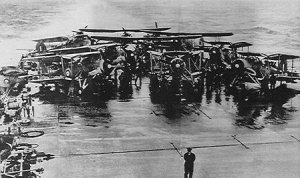 |
One Swordfish lost contact with the rest of the squadron in a cloud layer, and only eight planes proceeded to attack around midnight. The German anti-aircraft fire was very intense and even the main and secondary batteries opened fire. Lindemann and the helmsman, Hans Hansen, operating the press buttons of the steering gear, successfully avoided the first six torpedoes when suddenly the battleship was hit. A 18 inch MK XII torpedo struck Bismarck's starboard side, amidships, at the level of the main belt which resisted the explosion very well. The damage was minimal, although the explosion caused the death of OberbootsmannKurt Kirchberg (who became the first casualty aboard) and injured six men.
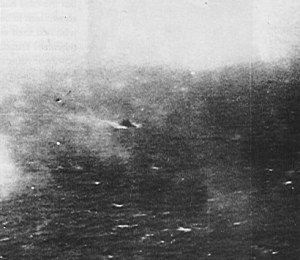 |
After the Swordfish attack, the Bismarck reduced her speed to 16 knots to alleviate the pressure in the forecastle and carry out repairs. The distance between both forces decreased, and at 0131 on 25 May (Lütjens' 52th birthday), the Prince of Walesopened fire on Bismarck. The battleships exchanged two salvoes each at a range of 15,000 meters (16,400 yards), but due to the poor visibility neither side scored any hits. The morale aboard the Bismarckwas high and sometime about then, the crew wished the Chief of Fleet a happy birthday by the ship's loudspeaker system.
Admiral Lütjens Makes His Move.
All three British ships that were shadowing the Bismarck from the port quarter had begun to zig-zag in case of a possible U-boat attack. At 0306, taking advantage of the enemy’s disposition and the darkness, Lütjens saw his opportunity to break the contact with his pursuers. The Bismarck increased her speed to 27 knots and turned to starboard, in a manoeuvre very similar to the one executed the previous afternoon when thePrinz Eugen was detached. The Bismarck succeeded in breaking contact and established a new course of 130º due southeast, to Saint-Nazaire. The British ships tried in vain to re-establish contact with theBismarck, and at 0401 the Suffolk reported: "Enemy contact lost."
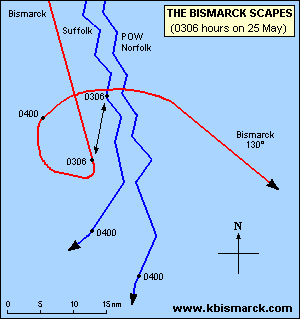 |
Nevertheless, on board the Bismarck they did not realize that the contact had been broken, and at 0700 Admiral Lütjens sent the following message to the Group West: "One battleship, two heavy cruisers keeping contact." At 0900, Lütjens sent another long message to the Group West. Neither message reached Group West until well after 0900. Ironically, Group West had previously sent (at 0846) a message confirming that the British had lost contact. After this,Bismarck kept strict radio silence, but the British had already intercepted her signals allowing them to calculate her approximate position.
At 1152, Lütjens received a personal message from Admiral Raeder: "Heartiest Birthday Wishes! In view of your recent great armed feat, may you be granted many more such successes [as you enter] a new year of your life!" Minutes later, at noon, Lütjens delivered the following speech to the crew by the loudspeakers:
- "Soldiers of the battleship Bismarck! You have achieved great fame! The sinking of the battlecruiser Hood does not only have a military, but also a morale [psychological] value [significance], because Hood was England’s pride. The enemy will now attempt to gather its forces and deploy them toward us. Therefore, I released Prinz Eugen yesterday noon so that he can conduct his own war on merchant vessels. He has accomplished to evade the enemy. By contrast, because of the hits we have sustained, we have received the order to head for a French harbour. The enemy will gather on the way and will engage us in battle. The German Nation is with you [in spirit] and we will fire until the barrels glow and until the last projectile has exited the barrel. For us soldiers [the battle cry] as of now is: “Victory or death!”
The Bismarck is Located.
In the morning of 26 May, as the Bismarck was approaching the French coast, the crew was ordered to repaint the top of the main and secondary turrets yellow. Hard job considering the state of the seas, nevertheless it was carried out although the yellow paint washed off at least once.
A few hours earlier, at 0300, two Coastal Command Catalina flying boats had taken off from Lough Erne in Northern Ireland on a reconnaissance mission in search for the Bismarck. At about 1010, Catalina Z of 209 Squadron commanded by Dennis Briggs sighted the German battleship that immediately answered with very accurate anti-aircraft fire.2 The Catalina jettisoned her four depth charges and took evasive action after her hull was holed by shrapnel. Then reported: "One battleship, bearing 240º, distance 5 miles, course 150º. My position 49º 33' North, 21º 47' West. Time of transmission 1030/26." After more than 31 hours since the contact was broken, the Bismarck had been located again. Unfortunately for the British, however, Admiral Tovey's ships were too far away from the German battleship. The King George V was 135 miles to the north, and the Rodney (with a top speed of 21 knots) was 125 miles to the northeast. They would never catch up with the Bismarck unless her speed could be seriously reduced.
Only the Force H, under the command of Vice-Admiral Sir James F. Somerville, sailing from Gibraltar, had a chance to intercept Bismarck. The battlecruiser Renown (Captain Rhoderick R. McGriggor) was in the best position, but having lost the Hood only two days earlier, the Admiralty did not permit Renown to engage theBismarck. The best hope for the British was to launch an air strike from the carrier Ark Royal. The Ark Royal had already launched 10 Swordfish at 0835 to try find the Bismarck, and once the report of the Catalina sighting arrived, the two closest Swordfish altered course to intercept. At 1114, Swordfish 2H located the German battleship too, followed seven minutes later by the 2F. Shortly afterwards two more Swordfish, fitted with long-range tanks, were launched to relieve 2H and 2F and keep touch with Bismarck.
At 1450, fifteen Swordfish commanded by Lieutenant-Commander J. A. Stewart-Moore took off from the Ark Royal (Captain Loben E. Maund) to attack the Bismarck. At 1550, they obtained radar contact with a ship and dived to attack. The attack, however, turned out to be a failure since the ship sighted was actually the light cruiser Sheffield (Captain Charles A. Larcom) which had been detached from Force H to make contact with the Bismarck. Luckily for the British, the Sheffield was not hit by any of the 11 torpedoes launched because they had faulty magnetic pistols. Two torpedoes exploded upon hitting the water, three on crossing the cruiser wake, and the other six were successfully avoided. The Swordfish returned to the Ark Royalwhere they landed after 1700, but not without trouble because of the terrible weather conditions. The rise and fall of the stern was measured to be 56 feet, and three aircraft smashed their undercarriages against the flight deck. Shortly afterwards, at 1740, the Sheffield obtained visual contact with the Bismarck.
The British put every effort on one last attack. It would be dark soon, and they knew this was their last real chance to stop or at least slow down the Bismarck. If they failed again, the Bismarck would reach the French coast on the next day, since another air strike late at night was unlikely to succeed. Therefore, at 1915, another group comprised of fifteen Swordfish, mostly the same used in the previous attack, took off from the Ark Royal, and this time their torpedoes were armed with contact pistols.
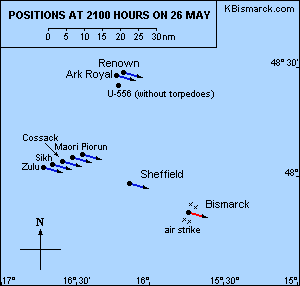 |
The Swordfish striking force, this time under the command of Lieutenant-Commander T.P. Coode, first approached the Sheffield to get the range and bearing to the Bismarck, and at 2047, began the attack.Bismarck's anti-aircraft battery opened fire immediately. During the course of the attack, theBismarck received at least two torpedo hits. One torpedo (or two) hit the port side amidships, and another struck the stern in the starboard side. The first hit did not cause important damage, but the second jammed both rudders at 12º to port. The Bismarck made a circle and then began to steer northwest involuntarily into the wind. As before, none of the Swordfish were shot down although some were hit several times. The damage to the Bismarck was so serious that at 2140, Admiral Lütjens sent the following message to Group West: "Ship unable to manoeuvre. We will fight to the last shell. Long live the Führer".
The impact in the stern area caused the flooding of the steering and other adjacent compartments. This meant that all repair attempts would have to be done under water. Divers were ordered to enter the steering compartment in order to free the rudders, but the violent movement of the water inside made this an impossible task. It was not possible to lower divers over the side due to the high seas. As an alternative, it was considered to blow the rudders away with explosives and try to steer the ship using the propellers alone, but the idea was rejected fearing that the explosion could damage the propellers.
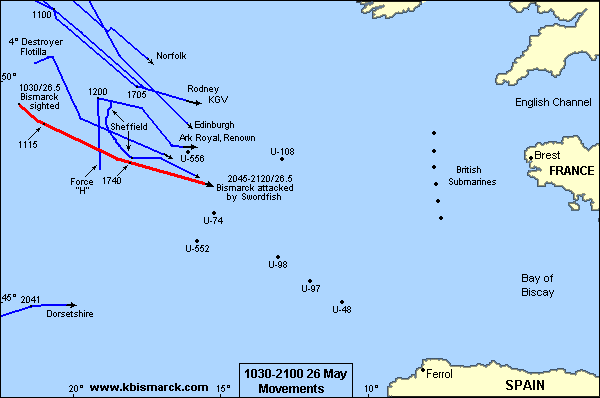
Destroyers Attack Bismarck.
After the aerial torpedo attack, the new erratic course of the Bismarck caused her to close the range with the Sheffield. At about 2145, Bismarck opened fire on the Sheffield at a range of about nine miles.Bismarck fired a total of six salvoes and the British cruiser turned away to the north under the cover of a smoke screen. The Sheffield was not hit, but some splinters disabled her radar and injured twelve men of whom three died later.3 The turn caused Sheffield to lose contact with Bismarck, but at 2200, she made contact with the destroyers of the 4th Flotilla (Captain Philip L. Vian) Cossack, Maori, Zulu, Sikh andPiorun, and provided them with the approximate bearing and distance to the German battleship.
At 2238, the Polish destroyer Piorun (Commander Eugeniusz Plawski) sighted the Bismarck. The German battleship responded shortly thereafter with three salvoes. The destroyers proceeded to attack, butBismarck defended herself vigorously in the dark. At 2342, splinters knocked down Cossack's antennas. Shortly after 0000, star shells from the destroyers began to illuminate the area. About an hour later, a star shell fell on Bismarck's bows starting a fire there that had to be extinguished by some crew members. Throughout the night the destroyers attacked the German battleship. These attacks were carried out in heavy seas, rain squalls and low visibility, and no torpedo hits were obtained on Bismarck, that time after time repelled every attack with heavy and accurate fire from her main and secondary batteries. By 0700, a total of 16 torpedoes had been fired by the destroyers of the 4th Flotilla.
Footnotes:
1. Lieutenant-Commander (A) Eugene Esmonde died on 12 February 1942 when his Swordfish was shot down while attacking the German ships crossing the English Channel. For this action he was posthumously awarded the Victoria Cross.
2. Dennis Briggs was not at the controls of Catalina Z/209 at the time. The man who actually sighted the Bismarck was the American US Navy Ensign Leonard “Tuck” Smith. The British only credited Briggs because he was the aircraft commander and didn’t want it known that Americans were involved since they were still considered neutrals.
3. On board Sheffield, Ordinary Seaman David T. George died on 26 May 1941, Able Seaman Ambrose Ling died on 27 May 1941, and Able Seaman Raymond C. Taylor died on 28 May 1941. The destroyers of the 4th Flotilla had the following casualties: Leading Stoker Ernest R. Potter aboard Sikh died on 26 May 1941, Petty Officer John Palmer aboard Maori died on 31 May 1941, and Leading Seaman William F. Dawe aboard Zulu died on 2 June 1941.
source : http://www.kbismarck.com/
Không có nhận xét nào:
Đăng nhận xét